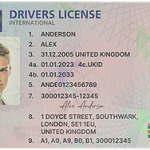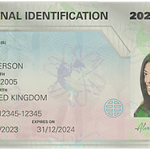Social media has become an integral part of modern – day communication and interaction. It has a wide – reaching influence on various aspects of society, including both positive and negative impacts. One of the more concerning and illegal aspects is its role in promoting the use of fake ID cards.
### Social Media as a Platform for Advertising Fake ID Cards
Social media platforms, with their large user bases and easy – to – use features, have unfortunately become a hotbed for the advertisement of fake ID cards. Fraudsters and illegal operators take advantage of the anonymity and wide reach of these platforms. They create accounts, often using fake or misleading information, and post advertisements for fake ID cards. These ads can range from simple text – based posts to more elaborate visual and video content.
For example, on some platforms, users may come across posts with captions like “Get your real – looking fake ID fast” or “High – quality fake IDs available for any purpose.” These posts are often accompanied by images of what are claimed to be high – quality fake ID cards, showcasing features such as holograms, barcodes, and accurate personal information replication. The use of eye – catching graphics and persuasive language is a common tactic to attract potential buyers.
### The Ease of Communication and Transaction Facilitated by Social Media
Another way social media promotes the use of fake ID cards is by facilitating communication between sellers and buyers. Messaging features on platforms like Facebook Messenger, WhatsApp, and Instagram Direct allow for direct and often encrypted communication. This makes it difficult for law enforcement agencies to monitor and intercept these conversations.
Sellers can provide detailed information about their products, such as the types of IDs available (driver’s licenses, passports, etc.), the quality levels, and the prices. They can also negotiate terms of payment and delivery with buyers. For instance, some sellers may offer payment methods like cryptocurrency, which provides an extra layer of anonymity for both parties. Once the deal is struck, the seller can arrange for the fake ID to be shipped to the buyer, often using untraceable or disguised shipping methods.
### Social Media Communities and Peer Influence
There are also social media communities that, either intentionally or unintentionally, promote the use of fake ID cards. For example, certain groups on platforms like Reddit or Discord may discuss ways to obtain fake IDs, share experiences with using them, or recommend specific sellers. In these communities, individuals may feel a sense of peer – pressure or acceptance when it comes to engaging in illegal activities such as using fake ID cards.
Young people, in particular, may be more susceptible to this peer influence. They may see posts or discussions in these communities and be lured into believing that using a fake ID is a common and relatively harmless activity. The normalization of such behavior within these online communities can have a significant impact on an individual’s decision – making process.
### The Impact of Social Media – Promoted Fake ID Usage
The promotion of fake ID cards through social media has far – reaching consequences. Firstly, it undermines the integrity of identity verification systems. Fake ID cards can be used for a variety of illegal activities, such as underage drinking, entering restricted areas, or even more serious crimes like identity theft and fraud.
Secondly, it poses a risk to public safety. For example, if someone with a fake ID is able to obtain a driver’s license, they may be driving on the roads without proper training or authorization, increasing the risk of accidents. Additionally, the use of fake passports or other travel – related fake IDs can pose a threat to national security, as it may allow unauthorized individuals to cross borders undetected.
### Common Problems and Solutions
#### Problem 1: Difficulty in Detecting Fake ID Advertisements
One of the main problems is that it can be extremely difficult for social media platforms to detect and remove all fake ID advertisements. Fraudsters use various tactics to bypass content – moderation algorithms, such as using coded language or changing the format of their posts.
**Solution**: Social media platforms should invest in more advanced artificial intelligence and machine – learning technologies. These can be trained to recognize patterns associated with fake ID advertisements, including specific keywords, image features, and communication patterns. Additionally, platforms should encourage users to report such content. A well – trained user base can act as an additional layer of defense, flagging suspicious posts for review by the platform’s moderators.
#### Problem 2: Encrypted Communication Hindering Law Enforcement
The use of encrypted messaging services on social media makes it challenging for law enforcement agencies to monitor and intercept conversations related to the sale and purchase of fake ID cards.
**Solution**: Law enforcement agencies should work with social media companies to develop legal frameworks that allow for limited access to encrypted conversations in cases of suspected illegal activity. This could involve court – ordered access, where a judge reviews the evidence and authorizes the interception of relevant communications. At the same time, social media companies should also be more transparent about their encryption methods and cooperate with law enforcement in a way that balances privacy concerns and public safety.
#### Problem 3: Peer Influence in Social Media Communities
The normalization of fake ID usage within social media communities can lead to more individuals engaging in this illegal activity.
**Solution**: Social media platforms should actively moderate and police these communities. They should ban groups or accounts that promote or discuss illegal activities such as obtaining or using fake ID cards. Additionally, educational campaigns can be launched on social media itself. These campaigns can target young people in particular, highlighting the legal, social, and personal risks associated with using fake ID cards. By raising awareness, individuals may be less likely to be influenced by peer – pressure within these communities.
#### Problem 4: Evasion of Payment and Shipping Detection
Sellers of fake ID cards often use methods like cryptocurrency for payment and untraceable shipping methods to avoid detection.
**Solution**: Financial institutions should be more vigilant in monitoring cryptocurrency transactions. They can work with law enforcement to identify patterns of transactions associated with illegal activities, such as the purchase of fake ID cards. For shipping, postal services and courier companies should implement more rigorous screening processes. This could include using advanced imaging technologies to detect suspicious packages and cross – referencing shipping information with known illegal activity databases.
#### Problem 5: Lack of Coordination between Platforms and Law Enforcement
There is sometimes a lack of effective coordination between social media platforms and law enforcement agencies in combating the promotion of fake ID cards.
**Solution**: Establishing formal partnerships and communication channels between social media companies and law enforcement is crucial. Regular meetings and information – sharing sessions can be organized to ensure that both parties are aware of the latest trends and threats related to fake ID card promotion. Additionally, joint task – forces can be set up to conduct coordinated investigations and take action against fraudsters operating on social media platforms.
In conclusion, the role of social media in promoting the use of fake ID cards is a serious issue that requires multi – faceted solutions. By addressing the various problems through a combination of technological advancements, legal measures, and educational initiatives, it is possible to reduce the prevalence of this illegal activity on social media platforms.


